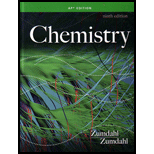
Concept explainers
(a)
Interpretation:
The given pressure 4.8 atm of Freon-12 is to be converted to mm Hg, torr, Pa and psi units.
Concept Introduction:
Pressure of a substance can be stated in various units. The units of pressure are interconvertible. The relations between units of pressure are,
- Since the unit mm Hg and the unit torr is used interchangeably.
- 1 atm pressure is about 105 Pa. that is,
- The 1 atm pressure in psi unit is,
(b)
Interpretation:
The given pressure 4.8 atm of Freon-12 is to be converted to mm Hg, torr, Pa and psi units.
Concept Introduction:
Pressure of a substance can be stated in various units. The units of pressure are interconvertible. The relations between units of pressure are,
- Since the unit mm Hg and the unit torr is used interchangeably.
- 1 atm pressure is about 105 Pa. that is,
- The 1 atm pressure in psi unit is,
(c)
Interpretation:
The given pressure 4.8 atm of Freon-12 is to be converted to mm Hg, torr, Pa and psi units.
Concept Introduction:
Pressure of a substance can be stated in various units. The units of pressure are interconvertible. The relations between units of pressure are,
- Since the unit mm Hg and the unit torr is used interchangeably.
- 1 atm pressure is about 105 Pa. that is,
- The 1 atm pressure in psi unit is,
(d)
Interpretation:
The given pressure 4.8 atm of Freon-12 is to be converted to mm Hg, torr, Pa and psi units.
Concept Introduction:
Pressure of a substance can be stated in various units. The units of pressure are interconvertible. The relations between units of pressure are,
- Since the unit mm Hg and the unit torr is used interchangeably.
- 1 atm pressure is about 105 Pa. that is,
- The 1 atm pressure in psi unit is,
Trending nowThis is a popular solution!
Learn your wayIncludes step-by-step video

Chapter 5 Solutions
Chemistry (AP Edition)
- What is the product of the following reaction? Please explain what is happening in this question. Provide a detailed explanation and a drawing showing how the reagent is reacting with the catalysts to product the correct product. The correct answer is B.arrow_forwardWhat is the missing intermediate 1 and the final product 2. Please include a detailed explanation explaining the steps of malonic ester synthesis. Please include drawings of the intermediate and how it occurs and how the final product is former.arrow_forwardWhat would be the reagents and conditions above and below the arrow that will complete the proposed acetoacetic ester synthesis? If it cannot be done efficiently, then I will choose that answer. There could be 2 or 4 reagents involved. Please provide a detailed explanation and drawings showing how it would proceed with the correct reagents.arrow_forward
- For benzene, the ∆H° of vaporization is 30.72 kJ/mol and the ∆S° of vaporization is 86.97 J/mol・K. At 1.00 atm and 228.0 K, what is the ∆G° of vaporization for benzene, in kJ/mol?arrow_forwardThe reaction Q(g) + R(g) → Z(l) is shown to be exothermic. Which of the following is true concerning the reaction. it is spontaneous only at High T, it is spontaneous at low T it is nonspontaneous at all T it is spontanrous at all T. it is non spontaneous only at low T.arrow_forwardThe reaction Q(g) + R(g) → Z(l) is shown to be exothermic. Which of the following is true concerning the reactionarrow_forward
- Which of the following has the largest standard molar entropy, S° (298.15 K) He H2 NaCl KBr Hgarrow_forwardWhich of the following is true for a particular reaction if ∆G° is -40.0 kJ/mol at 290 K and –20.0 kJ/mol at 390 K?arrow_forwardWhat is the major product of the following reaction? O O OH OH 1. BH 2. H₂O₂, NaOH OH OHarrow_forward
 ChemistryChemistryISBN:9781305957404Author:Steven S. Zumdahl, Susan A. Zumdahl, Donald J. DeCostePublisher:Cengage Learning
ChemistryChemistryISBN:9781305957404Author:Steven S. Zumdahl, Susan A. Zumdahl, Donald J. DeCostePublisher:Cengage Learning
 General Chemistry - Standalone book (MindTap Cour...ChemistryISBN:9781305580343Author:Steven D. Gammon, Ebbing, Darrell Ebbing, Steven D., Darrell; Gammon, Darrell Ebbing; Steven D. Gammon, Darrell D.; Gammon, Ebbing; Steven D. Gammon; DarrellPublisher:Cengage Learning
General Chemistry - Standalone book (MindTap Cour...ChemistryISBN:9781305580343Author:Steven D. Gammon, Ebbing, Darrell Ebbing, Steven D., Darrell; Gammon, Darrell Ebbing; Steven D. Gammon, Darrell D.; Gammon, Ebbing; Steven D. Gammon; DarrellPublisher:Cengage Learning Chemistry: An Atoms First ApproachChemistryISBN:9781305079243Author:Steven S. Zumdahl, Susan A. ZumdahlPublisher:Cengage LearningChemistry: Matter and ChangeChemistryISBN:9780078746376Author:Dinah Zike, Laurel Dingrando, Nicholas Hainen, Cheryl WistromPublisher:Glencoe/McGraw-Hill School Pub Co
Chemistry: An Atoms First ApproachChemistryISBN:9781305079243Author:Steven S. Zumdahl, Susan A. ZumdahlPublisher:Cengage LearningChemistry: Matter and ChangeChemistryISBN:9780078746376Author:Dinah Zike, Laurel Dingrando, Nicholas Hainen, Cheryl WistromPublisher:Glencoe/McGraw-Hill School Pub Co Chemistry for Engineering StudentsChemistryISBN:9781337398909Author:Lawrence S. Brown, Tom HolmePublisher:Cengage Learning
Chemistry for Engineering StudentsChemistryISBN:9781337398909Author:Lawrence S. Brown, Tom HolmePublisher:Cengage Learning





